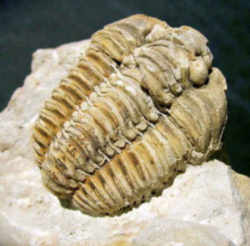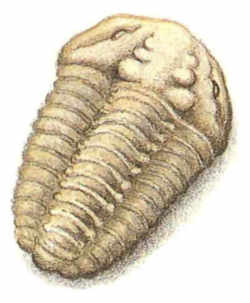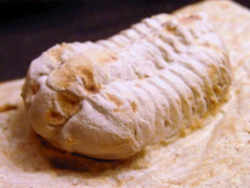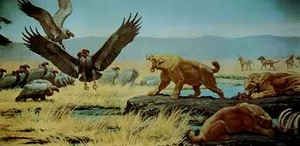Wisconsin State Fossil
Trilobite

(Calymene celebra)
Adopted on April 2, 1986.
1985 Wisconsin Act 162 amended Section 1.10 to designate the trilobite, (Calymene celebra,) as the official state fossil. The Wisconsin Geological Society proposed a state fossil in 1985 to encourage interest in the geological heritage.
The trilobite (pronounced "TRY-low-bite") is an extinct marine arthropod that was common in the warm, shallow salt sea that periodically covered the state during the Late Ordovician and Silurian Periods, some 450 - 400 million years ago. At that time Wisconsin was about 30? south of the equator, and the coral reefs that were abundant in the warm seas were home to a teeming ecosystem of brachiopods, mollusks, and crinoids, as well as trilobites.
The trilobite was said to be the best suited for the state fossil because no other fossil had been the subject of so much attention in Wisconsin by both amateur and professional alike.
Wisconsin State Fossil: Trilobite

Trilobites were arthropods (related to insects and crabs), and as such, possessed a segmented body, jointed appendages, and an exoskeleton. Many types of trilobites could roll themselves up in a ball like a pill bug to protect their soft underbelly from predators. Calymene was a bottom-dweller that crept along the sea floor in search of food. Calymene itself lasted only until the end of the Devonian, and all trilobites went extinct at the end of the Paleozoic Era in the mass extinction that wiped out over 90% of the species on earth.
The three-lobed creature had a tough, furrowed exoskeleton that was shed as the animal grew and molted. The Trilobite fossils range from 1 inch to 14 inches in length, with the average about 1-2 inches. The trilobite fossils are preserved in many rock formations throughout most of Wisconsin. This fossil put up a good fight against the mastodon, a large prehistoric, elephant-like creature for first place in the history books.
CALYMENE CELEBRA-WISCONSIN
Source: All text below is taken directly from the magazine Fossil News: The Journal of Avocational Paleontology, October
2000.
 Over the course of geological time Wisconsin
has been home to billions of species of intriguing life forms, from early arthropods to dinosaurs to the recent mammoths and musk ox, which only yesterday
disappeared from the state's fertile plains. Unfortunately, the most recent Ice Age, including the major glaciations which bears Wisconsin's name,
has wreaked havoc on the Dairy State's fossil record. Most of the central and northern parts of the state are nearly barren of fossils, instead being
filled with thick layers of glacial till. But, not the southern region. The area of Wisconsin extending from Prairie du Chien in the west to the urban
center of Milwaukee on the shores of Lake Michigan in the east are chock full of fossils, including a beautiful trilobite now known as the state fossil.
Over the course of geological time Wisconsin
has been home to billions of species of intriguing life forms, from early arthropods to dinosaurs to the recent mammoths and musk ox, which only yesterday
disappeared from the state's fertile plains. Unfortunately, the most recent Ice Age, including the major glaciations which bears Wisconsin's name,
has wreaked havoc on the Dairy State's fossil record. Most of the central and northern parts of the state are nearly barren of fossils, instead being
filled with thick layers of glacial till. But, not the southern region. The area of Wisconsin extending from Prairie du Chien in the west to the urban
center of Milwaukee on the shores of Lake Michigan in the east are chock full of fossils, including a beautiful trilobite now known as the state fossil.
About 420 million years ago much of the state of Wisconsin was covered by a large shallow sea. This warm body of water was a haven for life, and was
home to several species of crinoids, brachiopods, corals, and trilobites. One of these trilobites was Calymene celebra, a mid-sized arthropod
which thrived in shallow water. Like most arthropods, trilobites are divided into three basic body sections; the frontal cephalon, the middle thorax,
and the read pygidium. Calymene had a near triangular cephalon and possessed large, circular eyes. Its thorax and pygidium were further divided into
18-19 small segments, most of which were attached to legs and sensory bristles. These segments also had another use-they enabled the Calymene to roll
itself into a ball, much like the modern day pill bug. Many paleontologists believe that by rolling itself into a ball, the Calymene could protect
its soft underbelly from ocean predators, among them nautiloids and horseshoe crabs.
The first Calymene fossils were discovered in Wisconsin by naturalist Increase A. Lapham, who frequently explored the state's vast Niagara dolomite
outcroppings in the 1830's. For years scientists valued these 2-4 inch trilobites as index fossils, but it was not until 1982 when University of Wisconsin
geology buff Mark Shurilla waged a campaign to adopt the "trilobite" as the official state fossil. But paleontologist Klaus Westphal was
leery. Instead of having the ever-common trilobite as the state fossil, he suggested the exact species Calymene celebra. A bill was introduced
to the state legislature, but it was twice killed due to what some of the scientists dismissed as "dirty political tricks." However, in 1985
the third time was a charm, as the bill passed the legislature and was officially signed into law by Governor Early on April 2, 1986. It was truly
the end to a long saga, but unless another Ice Age hits it will be quite a long time until the famous Wisconsin Calymene celebra fossils disappear!
The Wisconsin Law
The law designating the trilobite as the official Wisconsin state fossil is found in the Wisconsin Statutes, Chapter 1, Section
1.10(3)(m)
CHAPTER 1. SOVEREIGNTY AND JURISDICTION OF THE STATE.
1.10. State song, state ballad, state waltz, state dance, and state symbols.
1.10(3) The Wisconsin state symbols are as follows:
1.10(3)(a)
(a) The mourning dove (zenaidura macroura corolinensis linnaus) is the symbol of peace.
1.10(3)(b)
(b) Milk is the state beverage.
1.10(3)(c)
(c) The sugar maple (acer saccharum) is the state tree.
1.10(3)(d)
(d) Corn (Zea mays) is the state grain.
1.10(3)(e)
(e) The wood violet (viola papilionacea) is the state flower.
1.10(3)(f)
(f) The robin (turdus migratorius) is the state bird.
1.10(3)(g)
(g) The muskellunge (Esox masquinongy masquinongy Mitchell) is the state fish.
1.10(3)(h)
(h) The badger (taxidea taxus) is the state animal.
1.10(3)(i)
(i) The dairy cow (bos taurus) is the state domestic animal.
1.10(3)(j)
(j) The white-tailed deer (odocoileus virginianus) is the state wildlife animal.
1.10(3)(k)
(k) The American water spaniel is the state dog.
1.10(3)(L)
(L) The honey bee (apis mellifera) is the state insect.
1.10(3)(m)
(m) The trilobite (calymene celebra) is the state fossil.
1.10(3)(n)
(n) Galena (lead sulfide) is the state mineral.
1.10(3)(o)
(o) Red granite is the state rock
1.10(3)(p)
(p) Antigo silt loam (typic glossoboralf) is the state soil.
1.10(3)(r)
(r) The cranberry (vaccinium macrocarpon) is the state fruit.
Taxonomic Hierarchy: Trilobite
Kingdom: AnimaliaPhylum: Arthropoda
Class: †Trilobita
Order: †Phacopida
Family: †Calymenidae
Genus: †Calymene
Species: †C. celebra
Binomial name: Calymene celebra - Raymond, 1916

Some states that lack a "state fossil" have nevertheless singled out a fossil for formal designation such as a state dinosaur, rock, gem or stone.







